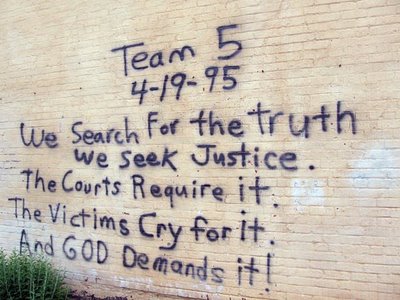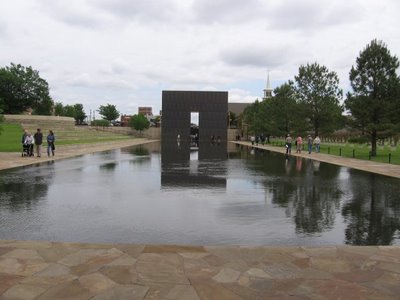
I remember this one particularly well. I was flying home from visiting a friend for Easter. As I waited to switch planes at Dulles, CNN on the TV at the gate was showing images of a building torn apart. At the time I was working for a weekly news magazine. "It's gonna be some week," I mumbled to myself. (It was.)
April 19, 1775, was the day of the "shot heard round the world," the first volley of the American Revolution. Longfellow immortalized the date in his poem about Paul Revere's ride the night before: "On the eighteenth of April in 'seventy-five--hardly a man is still alive/ who remembers that fateful day and year."

Various splinter groups in the 1990s liked to use mid-April to foment revolution. The Columbine shootings took place on April 20, Hitler's birthday. April 19, 1993, was the day the Branch Davidian compound burned to the ground in Waco, Texas, after a two-month siege. I should also point out that April 18, 1906, was the date of the famous San Francisco earthquake. Who cares about the Ides of March? Real trouble comes closer to May Day. Spring is a good time for revolutions. (Nixon's National Guard killed four students at Kent State in Ohio on May 4, which was also the anniversary of the Boxer Rebellion in China.)

When Tim McVeigh set off a truckload of explosives in front of the Alfred P. Murrah Federal Building in Oklahoma City on April 19, 1995, he thought he was sparking a second great American Revolution. He thought by striking this surprise blow against the U.S. Government, he would inspire countless like-minded rebels at every level of American society to take up arms and overthrow the system.
He was wrong.

At the time, this was the largest terrorist attack ever to take place on American soil. First fingers pointed at connections to the Middle East, until fast work by the FBI (and some luck) led to an American serviceman who had grown disillusioned with his country. It made the first World Trade Center bombing, which had taken place a few years before, look pale by comparison.
I had heard about this memorial, but by 2001 I'd never had a chance to see it. I wasn't terribly impressed with the pictures I'd seen. When I first got to the Oklahoma City memorial in 2001, after the World Trade Center buildings in New York had been destroyed, my first impression--with no disrespect--was to raise my eyebrows at how small Oklahoma's Federal Building had been. By comparison, this was an appetizer for destruction.
Which made it no less painful for those who suffered and lost loved ones. And even if the destruction of 9/11 was larger, the Oklahoma City bombing remains significant--and still troubling--because the attack came from within our own ranks, not from outside.

I was more impressed with the memorial on that visit than I had expected to be. It's quiet and understated, but it's also clear and evocative. The text scattered around the site is spare--a pithy phrase here, a sentence there, and of course the graffiti message left on an adjacent wall by rescuers--but it cuts deep. The site is bookended by two large black walls, with a time writ large on each: 9:01, when the bomb went off, at the east end of the memorial, and 9:03, when the building finished collapsing, facing it across the field of empty seats. In the span between those times, the 168 people represented by the chairs lost their lives.

I was pleased to have time to come back and visit again on this trip.
1 comment:
"Who cares about the Ides of March? Real trouble comes closer to May Day."
April is the cruellest month, after all:
APRIL is the cruellest month, breeding
Lilacs out of the dead land, mixing
Memory and desire, stirring
Dull roots with spring rain.
(Old Possum wrote that, of course.)
A.
Post a Comment